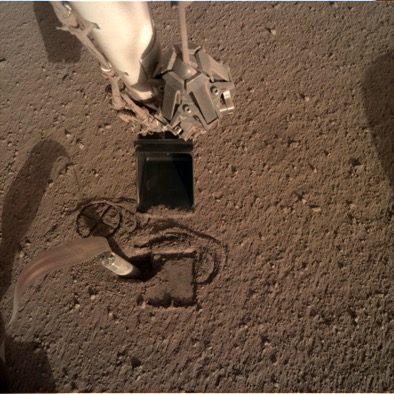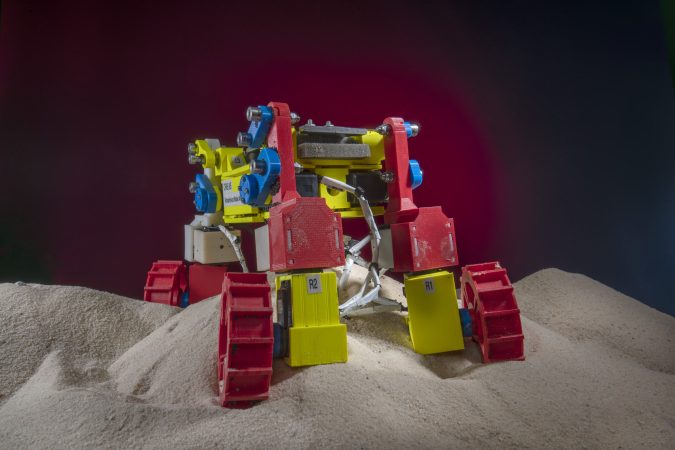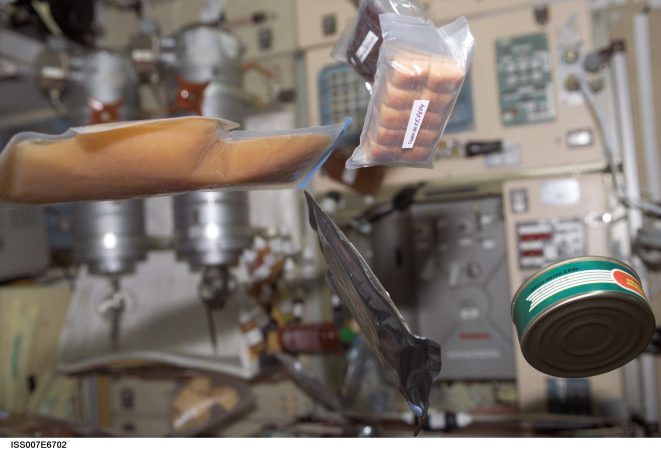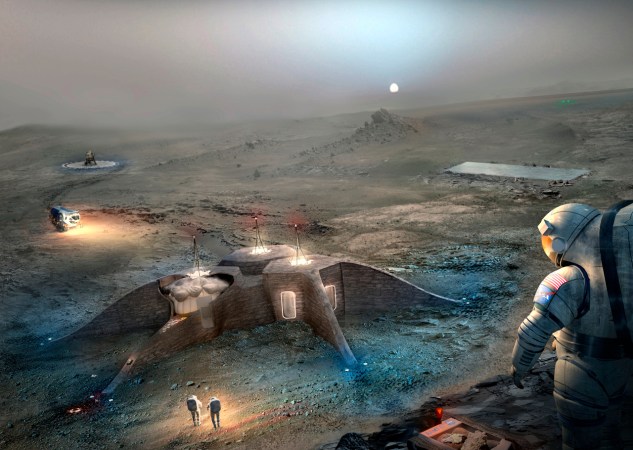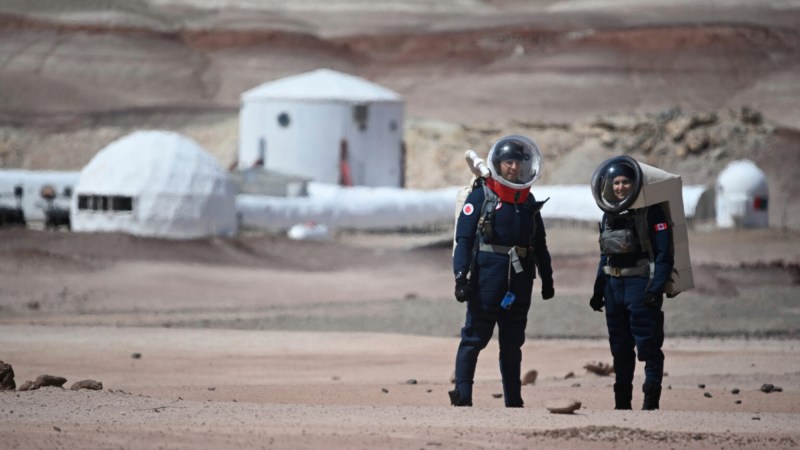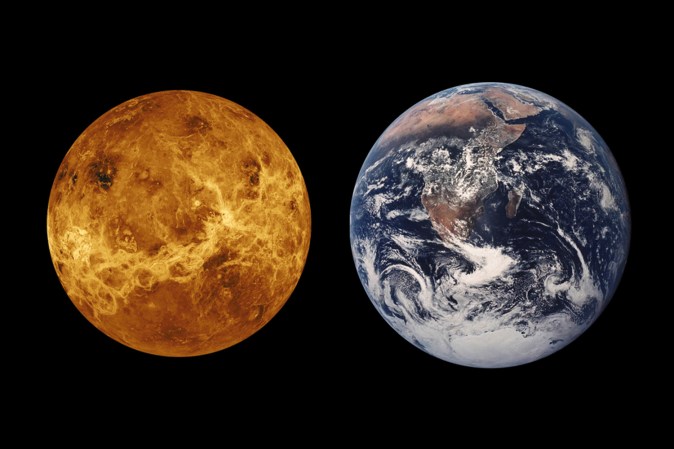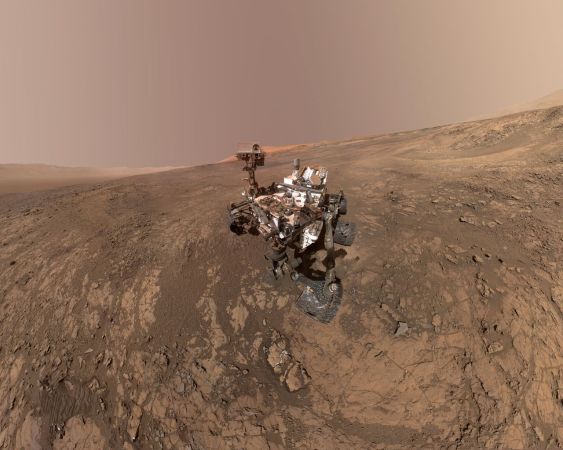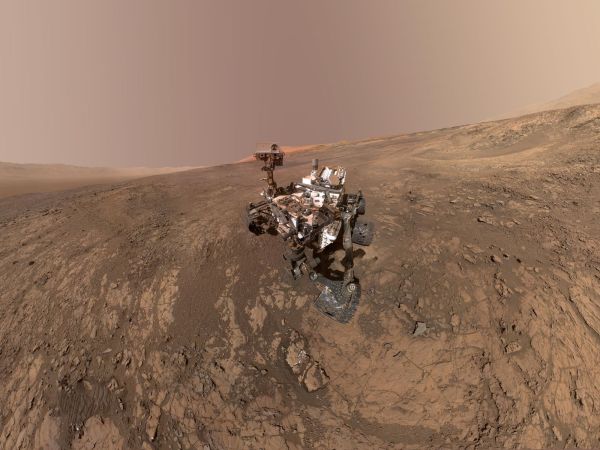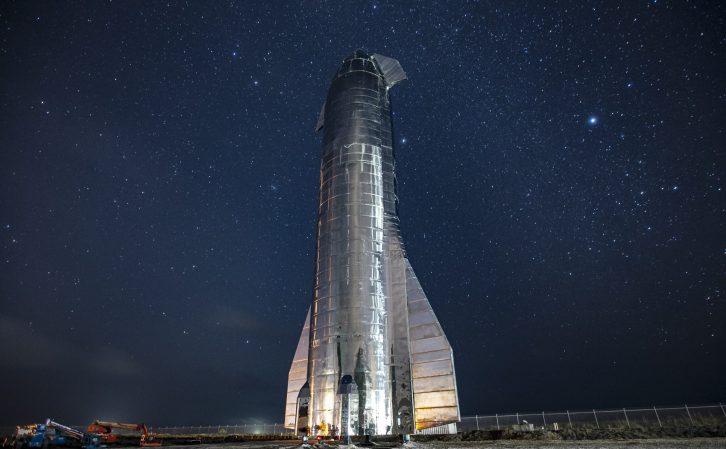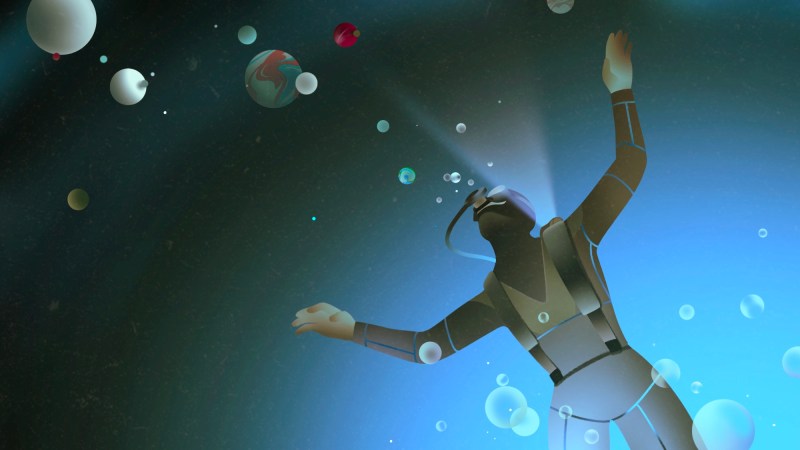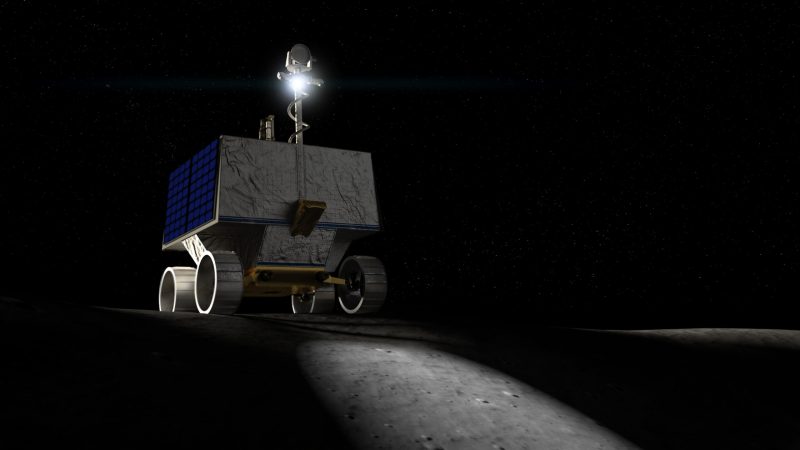

Jeffrey Montes stands high on a ladder in the middle of a dirt-floored arena, squinting at the oculus of what looks like the world’s largest vase. His khakis and black t-shirt are remarkably tidy for someone deploying red goo to build a one-third scale model of what might someday be a home on Mars. Cleanliness happens when you outsource the dirty work to a robot.
Montes and his colleagues at architecture firm AI SpaceFactory are in a cavernous exhibition hall near Peoria, Illinois, to show NASA how astronauts could use 3D printing and Martian materials to make houses on the Red Planet. After spending the better part of 30 hours watching their custom-built printer squirt out a chocolate-colored domicile called “Marsha,” they have just minutes before the agency calls time in its 3D-Printed Habitat Challenge. The company’s only competition for the $500,000 prize, a team from Penn State University, finished its gray concrete double igloo a few minutes before.
Think of housing on Mars, and that’s the kind of shape that might come to mind. But Montes, an architect who spent 17 months designing Marsha (for Mars habitat) and the equipment to print it, sees something that looks more like a jar. Or an urn. Or an egg. “It even has this hermaphroditic quality where on the outside it’s kind of phallic, and on the inside it’s…” He pauses. “Whatever the opposite of phallic is.” (Yonic.) Inside, Montes envisions several floors where residents of the Red Planet will live and work and play, and a skylight under which they will gaze at a starry sky or bask in sunlight refracted through the thin Martian atmosphere. But that means securing the round window atop a 15-foot structure that’s still squishy. The mixture sets quickly, but not quickly enough to meet NASA’s looming deadline. As the printer nozzle climbs higher, Marsha’s upper layers slump ever so slightly.
The robot finishes with three minutes to spare, then inches the polycarbonate skylight into position. With seconds remaining and dozens of people—including a film crew from NASA—watching, Montes gives the order to release it. Everyone holds their breath, hoping Marsha doesn’t cave in.

People settling on Mars will to some degree have to live off the land. At its closest, our neighboring planet lies 35 million miles away. Transporting supplies there will cost roughly $5,000 per pound and take at least six months using current technology. Better to enlist the natural resources of their new home when possible, an approach called in situ resource utilization. “It totally changes the logistics of a mission,” says Advenit Makaya, a materials engineer who develops processes like 3D printing at the European Space Agency. “You don’t have to bring everything with you.”
Humans on the Red Planet might draw power from the sun, mine water from buried ice, and harvest oxygen from the atmosphere. With NASA’s encouragement, architects, engineers, and scientists are exploring how early residents might use recycled waste and the planet’s loose rock and dust, called regolith, to craft tools, erect homes, pave launchpads and roads, and more.
Rovers and probes have revealed enough about Martian geology for us to start figuring out how that might work. The surface contains an abundance of iron, magnesium, aluminum, and other useful metals found here at home. Scientists also believe the crust consists largely of volcanic basalt much like the dried lava fields of Hawaii.
Here on Earth, researchers often employ crushed basalt as an analog for Martian regolith. They can heat and compress the sandy material, a process called sintering, to create paving tiles. NASA and aerospace agency Pacific International Space Center for Exploration Systems did exactly that in 2015, then had a robotic rover called Helelani use the pavers to build a launchpad 66 feet in diameter. Compacted regolith might even hold together without heat, according to a team led by Yu Qiao of the University of California at San Diego. Their 2017 study posits that iron oxide, which gives Mars its rusty tint, could serve as a binding agent.
Still, if you’re creating anything more complex than blocks, regolith can be a hassle. It lacks the plasticity that makes clay easy to manipulate. Working independently, Makaya’s team at the European Space Agency and researchers at Northwestern University printed tools and small objects, including gears and blocks. But their method requires mixing regolith with solvents and a sticky binder—all of which would have to be carried from Earth or made on Mars.
David Karl, a materials scientist and doctoral student at the Technical University of Berlin, thinks there’s an easier way. He works in a research laboratory that creates advanced ceramics for electronics, biomedical implants, and other applications. His background in art makes him prone to saying things like, “Cement looks beyond incredible under a microscope.” A few years ago, he and his academic adviser, Aleksander Gurlo (who also leads the lab), pondered how astronauts might use regolith without having to add anything hauled through space. It occurred to them that everyone trying to solve that riddle had overlooked an ancient solution: mixing the material with water, which humans around the world have done to make earthenware ceramics for at least 30,000 years.

They turned to a relatively simple method of pottery-making called slip casting. It calls for pouring a soupy mixture of clay and water, called slip, into a plaster mold and allowing it to set. Then you dump out the excess material and remove the object for firing in a kiln. Instead of using clay, Karl and Gurlo tried it with a simulated regolith called JSC-Mars-1A, which NASA developed in 1998, and a rotund mold from the Royal Porcelain Factory in Berlin. “You have no idea how hard it was to convince the engineering types I work with here to do some stupid vases as a big project,” Karl says.
The smooth, squat vases they created resemble terra cotta, and wouldn’t look out of place filled with flowers. Karl envisions greens sprouting from vessels like them in hydroponic gardens on another world. He also thinks refining the process could allow astronauts to slip-cast Red Planet mud into more-complex shapes with the help of a 3D printer.
Karl’s vases provide a glimpse of how Mars inhabitants might craft everyday objects, but NASA wants architects and engineers to consider where those pioneers might live. Four years ago, the agency invited them to enter the 3D-Printed Habitat Challenge.
Contestants navigated three escalating phases of competition. The first, completed in 2015, called on teams to create architectural renderings of their habitats. Two years later, entrants had to develop the tools needed to 3D-print dwellings, and create the beams, domes, and other structural elements needed to erect them. Teams came and went as the contest progressed, until just two entered the final, and hardest, event this year.
The rules, which ran 76 pages, required each group to print a one-third scale model of a four-person habitat with at least three openings within 30 hours. Judges awarded points for using materials like simulated regolith, and, because the competition emphasized automated construction, deducted points for intervening to, say, fuss with printer software or clear a clogged nozzle.
NASA likes the idea of robot construction crews because the habitats could be ready before humans arrive. Architect Shadi Nazarian found her way to Martian home design through her work studying how 3D printers might build more-resilient housing here on Earth. She leads a laboratory at Penn State University that explores creating seamless transitions between disparate materials such as glass and concrete, a technique that would eliminate joints that require caulking or epoxy. Such a trick would be handy on the Red Planet, where structures must be strong enough to withstand intense pressurization and protect inhabitants from frigid temperatures and solar radiation. So she and her colleagues, architect José Duarte and electrical engineer Sven Bilén, entered the NASA contest two years ago. Their sturdy conical habitat looks like a home on Tatooine or a centuries-old stone trullo hut in the Italian countryside.
Montes, the chief space architect at Penn State’s rival, AI SpaceFactory, encouraged the firm to enter after he joined it in 2017. David Malott, whose résumé includes three of the world’s tallest buildings, founded the New York company in part as a response to what he considers waste within the construction industry. Designing for space emphasizes local materials and sustainability, and requires anticipating astronauts’ psychological needs. Malott wants to show how such principles might work on Earth.
You see those concerns reflected in Marsha. Montes favored a tower because it maximizes usable space. The shape also easily divides into floors, and building up instead of out lends itself to 3D printing. He thinks the skylight, curved walls, and a Swiss-cheese-like interior shell will add variety and idiosyncrasy to daily life on a distant world.
Creating the model of Marsha’s outer shell required first spending many months developing the 3D printer and the goop it spits out. Montes’ team built an enormous machine that features an off-the-shelf nozzle—called an extruder—modified with grippers and various sensors. They mounted all that hardware to a robotic arm similar to those you’d see welding bodies or painting cars on an automobile assembly line. The “ink” the contraption lays down, layer by layer as it follows instructions from a computer, is a mixture of recyclable plastic grown by bacteria and fine basalt fibers that could theoretically be gleaned from Martian rock. “Just getting the material to ooze out was a happy day,” Malott says.

Habitat construction got off to a rough start the first day of the May 2019 competitions. The teams worked in an enormous exhibition hall owned by heavy-equipment manufacturer Caterpillar, which typically uses the space to demonstrate earth-movers and other big machines. The arena briefly lost power, causing hiccups in the teams’ printer programs, and wonky extrusions required occasional troubleshooting. Judges discreetly warned NASA’s Monsi Roman, who oversaw each of the phases leading up to the final event, to prepare for disappointment. But within a day, both teams found their momentum, and the mesmerizing whir of the printers drew company employees and field-tripping students to watch the structures rise in fits and starts.
The Penn State crew used an industrial robotic arm rigged with an extruder, but scuttled its plan to build with something it calls MarsCrete because the material, designed for the frigid environment of Mars, set too quickly at room temperature. The team switched to concrete made with conventional cement, but the mixture would jam the apparatus if the machine stopped or paused too long. “Printing with concrete is very, very difficult,” says planetary geologist Jennifer Edmunson, who was among the judges. Still, the team finished its tallest structure 11 minutes early. Cheers erupted as the machine sealed a habitat some in the crowd had taken to calling Dairy Queen because its twin 13-foot peaks resembled great swirls of soft-serve ice cream.
Marsha’s texture looked like an old sweater, each lump and seam and loose strand indicating a pause or deviation in the layering process. Montes did his best to minimize deformities by running the robot more slowly, but lost that luxury as time passed. With seconds left and the uppermost section drooping, Montes gave the order to release the skylight. The walls held for a moment, then the rim sagged inward, and the window fell to the floor with a thud. Montes descended the ladder to hesitant applause. “If you want drama, there’s drama,” he said to the NASA film crew.
Some wondered if the tumble doomed AI SpaceFactory’s chance of winning, even though the team had earned high scores in several categories and intervened in its automated print less often than the Penn State crew. After letting the habitats cure overnight, the judges spent a few hours beating them mercilessly to ensure they were airtight, check their impact resistance, and assess their strength. Dairy Queen proved remarkably robust during a simulated meteorite strike, enduring a barrage of increasingly heavy balls until the last one, a 26-pounder, removed a small chunk of the roof. More impressive, the structure resisted the crushing vertical assault of a 96-ton excavator—at least for a couple of minutes, before collapsing with the percussive crack of a bowler throwing a strike.
Strictly speaking, Marsha was incomplete because it lacked a roof. It clearly wasn’t airtight: The habitat emitted great plumes of colorful smoke when a contest official tossed a test flare into it. The judges saw no point to dropping fake meteorites on it either. The model, however, surrendered just a few small pieces to the excavator, which placed its bucket on Marsha’s rim and pushed down with enough force to raise the front of the rumbling machine’s treads off the ground.
After spending a few hours reviewing notes and tallying points, the judges named AI SpaceFactory the winner. Montes, grinning with teammates as they held an oversize check for $500,000, seemed almost as pleased as NASA’s Roman, who considered the build a great success. Despite their scars, the habitats provided perhaps the most tangible evidence yet of what homes on another world could look like. “They’re not perfect,” she said, “but they’re beautiful.”
This story originally published in the Out There issue of Popular Science.
